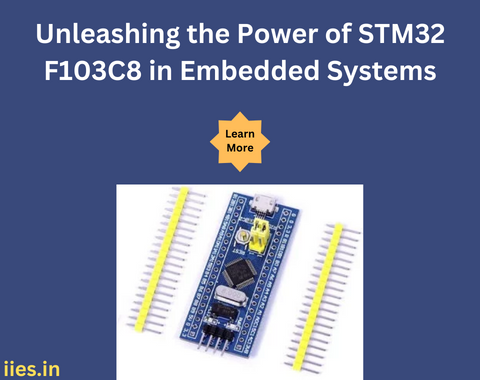
The STM32 F103C8 microcontroller, a member of the STM32 family developed by STMicroelectronics, stands out as a powerful and versatile embedded system solution. In this article, we will delve into the various aspects of the STM32 F103C8, exploring its features, architecture, applications, programming, and the advantages it offers to developers in the world of embedded systems.
The STM32 F103C8 is part of the STM32F1 series, which is based on the ARM Cortex-M3 architecture. It boasts a 32-bit RISC core running at a maximum frequency of 72 MHz, providing high processing power for a wide range of applications. With its Flash memory, RAM, and rich peripheral set, the F103C8 is suitable for diverse projects, from simple control systems to more complex applications.
A. Core Architecture
The heart of the STM32 F103C8 is its ARM Cortex-M3 core, offering efficient and high-performance processing. The Cortex-M3 architecture is well-suited for real-time applications, making the F103C8 an excellent choice for embedded systems that require precise timing and responsiveness.
B. Memory
The microcontroller comes equipped with Flash memory ranging from 64 to 128 KB, providing ample space for program storage. Additionally, it features 20 KB of SRAM, ensuring sufficient memory for data storage and manipulation during runtime.
C. Peripherals
The STM32 F103C8 boasts a rich set of peripherals, including GPIO (General Purpose Input/Output), USART, SPI, I2C, ADC, timers, and more. These peripherals enhance the microcontroller’s versatility, enabling it to interface with a wide array of sensors, actuators, and communication modules.
A. Development Environment
Developers can program the STM32 F103C8 using various integrated development environments (IDEs) such as Keil µVision, STM32CubeIDE, and PlatformIO. These tools provide a user-friendly interface, powerful debugging capabilities, and support for various programming languages, including C and C++.
B. Programming Languages
The STM32 F103C8 is typically programmed using the C programming language due to its efficiency and proximity to hardware. However, developers can also leverage C++ to take advantage of its object-oriented programming features, making code organization and maintenance more straightforward.
C. Firmware Libraries
STMicroelectronics provides firmware libraries, known as the STM32 Standard Peripheral Library, which simplifies the development process by offering pre-written functions for common tasks. These libraries reduce development time and facilitate code reuse, contributing to more efficient and reliable applications.
The versatility of the STM32 F103C8 makes it suitable for a broad range of applications, including but not limited to:
A. Industrial Control Systems:
The microcontroller’s robust features make it well-suited for applications in industrial automation and control systems.
B. Internet of Things (IoT):
With its efficient processing capabilities and rich peripheral set, the F103C8 is ideal for IoT devices that require connectivity and real-time data processing.
C. Consumer Electronics:
The microcontroller can be found in various consumer electronics applications, such as home automation, smart devices, and multimedia systems.
D. Automotive Systems:
Its reliability and real-time capabilities make the F103C8 suitable for use in automotive control systems, including engine control units (ECUs) and vehicle communication modules.
A. Advantages
1. Cost-Effective: The STM32 F103C8 provides a cost-effective solution for embedded system development, making it accessible to a wide range of projects.
2. Versatility: The microcontroller’s rich peripheral set and processing power make it versatile, allowing developers to address diverse application requirements.
3. Community Support: The STM32 community is active and supportive, providing a wealth of resources, forums, and tutorials that aid developers in overcoming challenges.
B. Challenges
1. Limited Memory: While the STM32 F103C8 offers sufficient memory for many applications, developers working on larger projects may find the memory limitations restrictive.
2. Learning Curve: For beginners, the learning curve associated with embedded systems and microcontroller programming may pose a challenge. However, the wealth of online resources can help mitigate this.
A. USB Interface: The STM32 F103C8 includes a USB 2.0 full-speed interface, enabling seamless connectivity with other devices. This feature is particularly advantageous in applications where data transfer speed and reliability are crucial, such as in communication modules and data loggers.
B. CAN Interface: With an integrated Controller Area Network (CAN) interface, the microcontroller is well-suited for automotive applications, industrial automation, and other systems that require robust and efficient communication between nodes.
C. Ethernet Connectivity: Some variants of the STM32 F103 series are equipped with an Ethernet peripheral, allowing developers to implement networked applications, making it suitable for projects requiring internet connectivity or local network communication.
The STM32 F103C8 supports various low-power modes, enhancing energy efficiency in battery-powered applications. Developers can leverage these modes to optimize power consumption based on the specific requirements of their projects, extending battery life and reducing overall power consumption.
The STM32 F103C8 microcontroller stands as a powerful and flexible solution for embedded systems development. With its ARM Cortex-M3 core, rich peripheral set, and cost-effectiveness, it has gained popularity among developers across various industries. As technology continues to advance, the STM32 F103C8 remains a reliable choice for those seeking a balance between performance, versatility, and affordability in their embedded projects
Indian Institute of Embedded Systems – IIES